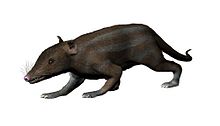Juramaia
| Juramaia | |
|---|---|

| |
| Restoration | |
| Scientific classification | |
| Domain: | Eukaryota |
| Kingdom: | Animalia |
| Phylum: | Chordata |
| Class: | Mammalia |
| Clade: | Eutheria |
| Genus: | †Juramaia Luo et al., 2011 |
| Species | |
Juramaia is the earliest known eutherian mammal. It is a small shrew-like mammal of body length about 70–100 mm. It is an extinct genus from the Upper Jurassic deposits of western Liaoning, China.[1]
A nearly complete skeleton, with an incomplete skull with full dentition was found. It was collected in the Daxigou site, Jianchang, from the Tiaojishan Formation. It is dated at about 160 million years ago.[2]
The discovery of Juramaia provides new insight into the evolution of eutherian mammals. It shows their lineage diverged from that of the marsupials 35 million years earlier than previously thought.[2] Furthermore, its discovery fills gaps in the fossil record and helps to calibrate modern, DNA-based methods of dating the evolution.[3][4]
The forelimb bones have climbing adaptations, so it is suggested that the basal stock of Eutheria was arboreal.[2]
Related pages[change | change source]
References[change | change source]
- ↑ Juramaia sinensis - 160-million-year-old fossil pushes back mammal evolution
- ↑ 2.0 2.1 2.2 "A Jurassic eutherian mammal and divergence of marsupials and placentals" (PDF). Nature. 476 (7361): 442–445. 2011. Bibcode:2011Natur.476..442L. doi:10.1038/nature10291. PMID 21866158. S2CID 205225806. Archived from the original (PDF) on 2013-11-10. Retrieved 2016-02-16.
{{cite journal}}: Cite uses deprecated parameter|authors=(help) Electronic supplementary material - ↑ "Fossil redefines mammal history" BBC News
- ↑ Discovery of a 160-million-year-old fossil represents a new milestone in early mammal evolution
